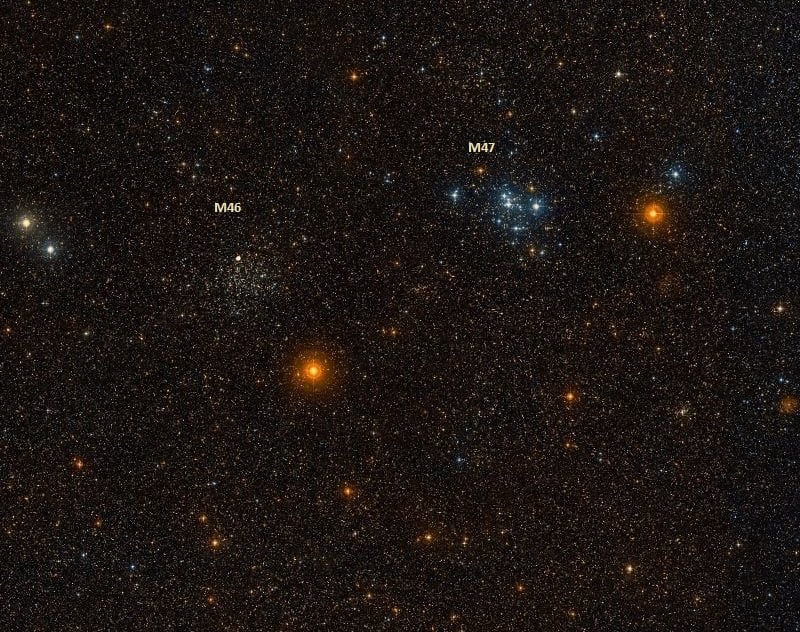Welcome back to Messier Monday! In our ongoing tribute to the great Tammy Plotner, we take a look at Orion's Nebula's "little brother", the De Marian's Nebula!
During the 18th century, famed French astronomer
Charles Messier
noted the presence of several "nebulous objects" in the night sky. Having originally mistaken them for comets, he began compiling a list of them so that others would not make the same mistake he did. In time, this list (known as the
Messier Catalog
) would come to include 100 of the most fabulous objects in the night sky.
One of these objects is the open star cluster known as Messier 46, which is located about 5,500 light years away in the southern Puppis constellation. Located in close proximity to another open cluster (Messier 47), this bright, rich cluster is about 300 million years old and is home to many stars - an estimated 500 - and some impressive nebulae too.
Description:
Crammed into about 30 light years of space, around 150 resolvable stars and up to 500 possible stellar members all took off together on a journey through space some 300 million years ago. At this point in time, they are about 5,400 light years away from our solar system, but they aren't standing still. They're pulling away from us at a speed of 41.4 kilometers per second.
[caption id="attachment_136006" align="aligncenter" width="580"]
The Messier 46 open star cluster. Credit: Jose Luis Martinez
[/caption]
If you notice something just a bit different about one of the stars along the northern edge - then you've caught on to one of the most famous features of Messier 46 - its resident planetary nebula. While radial velocities show it probably isn't a true member of the cluster, it's still a cool feature!
But, is there more to this cluster than that? You bet. Messier 46 has also been highly studied for its core properties. As Saurabh Sharma (et al) indicated in a
2006 study
:
History of Observation:
Messier 46 is an original discovery of Charles Messier, caught on February 19, 1771, just after he released his first catalog of entries. In his journal, he wrote:
[caption id="attachment_136007" align="aligncenter" width="548"]
Messier 46 and NGC 2437. Credit: NASA[/caption]
At the time of its discovery, Messier had not published his findings quite as immediately as we do today, so another astronomer also independently discovered this cluster as well... Caroline Herschel. "March 4th, [17]83. 1 deg S following the nebula near the 2nd Navis... a Nebula the figure is done by memory. My Brother observed it with 227 and found it to be, an astonishing number of stars. it is not in Mess. catalogue."
It would be John Herschel in 1833 who would discover the planetary nebula while cataloging it: "The brightest part of a very fine rich cluster; stars of 10th magnitude; which fills the field. Within the cluster at its northern edge is a fine planetary nebula."
But, as always, Admiral Symth has a way with words and observations. As he wrote of the object:
Pretty amazing considering these gentlemen did all of their observations visually and knew nothing about today's parallaxes, radial velocities or any other type of thing. May your own observations be as talented...
Locating Messier 46:
There is no simple way of finding Messier 46 in the finderscope of a telescope, but it's not too hard with binoculars. Begin your hunt a little more than a fistwidth east/northeast of bright Sirius (Alpha Canis Majoris)... or about 5 degrees (3 finger widths) south of Alpha Monoceros. There you will find two open clusters that will usually appear in the same average binocular field of view. M46 is the easternmost of the pair.
[caption id="attachment_136005" align="aligncenter" width="461"]
Messier 46 location. Credit: IAU/Sky & Telescope magazine (Roger Sinnott & Rick Fienberg)
[/caption]
It will appear slightly dimmer and the stars will be more concentrated. In the finderscope it will appear as a slightly foggy patch, while neighboring western M47 will try to begin resolution. Because M46's stars are fainter, it is better suited to darker sky conditions, showing as a compression in binoculars and will resolve fairly well with even a small telescope. However, you will need at least a 6" telescope to perceive the planetary nebula.
And here are the quick facts on this Messier Object to help you get started:
- Object Name
-
Messier 46
- Alternative Designations
-
M46, NGC 2437
- Object Type
-
Open Galactic Star Cluster
- Constellation
-
Puppis
- Right Ascension
-
07 : 41.8 (h:m)
- Declination
-
-14 : 49 (deg:m)
- Distance
-
5.4 (kly)
- Visual Brightness
-
6.0 (mag)
- Apparent Dimension
-
27.0 (arc min)
We have written many interesting articles about Messier Objects here at Universe Today. Here's Tammy Plotner's
Introduction to the Messier Objects
, ,
M1 – The Crab Nebula
,
M8 – The Lagoon Nebula
, and David Dickison's articles on the
2013
and
2014
Messier Marathons.
Be to sure to check out our complete
Messier Catalog
. And for more information, check out the
SEDS Messier Database
.
Sources:
- Messier Objects - Messier 46
- Wikipedia - Messier 46
- *SEDS - Messier 46*
 Universe Today
Universe Today
